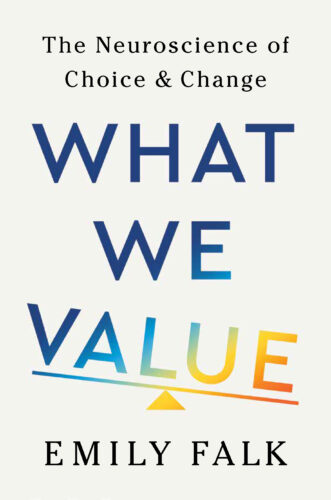Have you ever wondered why you hesitate to reach out to an old friend, or why you keep pushing off your goal to get in shape? Why you spend hours scrolling through your phone instead of starting that passion project? How to come up with more innovative ideas at work? We make hundreds of choices every day, but even when we know what’s good for us, following through is rarely easy.

As director of the Communication Neuroscience Lab and the Annenberg Public Policy Center’s Climate Communication Division, Annenberg School for Communication professor Emily Falk spends a lot of time thinking about the neuroscience of decision making, behavior change, and successful communication.
Now, Falk has published her first book, “What We Value: The Neuroscience of Choice and Change,” grounded in both personal anecdotes and stories from public figures in entertainment and sports.
“I hope if people understand how their brains work, it could give them more agency in thinking about the choices and the possibilities that they have,” Falk says. “Understanding how the brain works might help us make sense of our choices, explore different paths in our decision making, make changes that are aligned with our goals, and connect with others in new ways.”
She says, “Part of the reason that I love communication as a field is because it is so central to our health and happiness at so many levels. Being connected to other people is fundamental to our mental well-being and to our physical survival and health.”
Falk talked to Penn Today about takeaways from the book, her process, and inspirations.
‘What We Value: The Neuroscience of Choice and Change’
 Q: You start the book writing about the value system and the self-relevance system. What are they, and how do they shape the choices we make?
Q: You start the book writing about the value system and the self-relevance system. What are they, and how do they shape the choices we make?
Emily Falk: The value system and self-relevance system are two core networks in the brain that shape how we make choices, whether we realize it or not. The value system helps us assess what’s worth our time, attention, and effort. It calculates the value of each option we consider, basically asking, ‘What’s the likely possibility for reward here?’ Our self-relevance system helps us identify things that are ‘me’ or ‘not me.’
One of the things I talk about in the book is how much overlap there is between self-relevance and value judgments. Things that are perceived as ‘me’ are often also thought of as more positive or good; things that are thought of as ‘not me’ are less positive and less good. That can be helpful for maintaining a positive sense of self, but it can also limit us in the possibilities that we see for ourselves.
Q: What can we learn from neuroscience research about how to change our behaviors and how our social relationships impact behavior change?
EF: Neuroscience has shown that behavior change is not just about willpower; it’s about how our brains assign value to different choices and how that value can shift in different contexts and environments. In general, you might prefer coffee over tea, but you might change your mind if it’s midnight and you’re already feeling over-caffeinated, or if a friend raves to you about a new boba place. Change happens when new behaviors start to feel rewarding.
As we think about changing our own behaviors, one insight is that the value system tends to prioritize immediate reward. Knowing that, we can think about how to make things that are compatible with our bigger-picture goals more immediately rewarding. If I want to get more exercise, how can I make that more fun in the moment, like by listening to an exciting audiobook or watching a television show I wouldn’t otherwise watch or doing it with a friend?
Thinking about the self-relevance system, one of the issues we run into is defensiveness. We can be reluctant to trade in behaviors or ideas that we think of as ours, and so one way to get around that is interventions that help us zoom out and connect with the bigger world. If you take a moment to reflect on your core values—such as family, creativity, loyalty, spirituality, or compassion—your brain becomes more receptive to messages about behavior change. Studies using brain imaging show that this type of values affirmation makes neural circuits involved in valuation and self-related processing more responsive to messages, making health or prosocial messages ‘land’ more effectively.
A third brain system I describe in the book is the social relevance system, which helps us understand what other people think and feel. This opens all kinds of possibilities for influence that we often don’t notice. Whether we’re connected to people who inspire us and share our goals or people whose actions and values we wouldn’t want to emulate if we stopped to think about it, their behaviors change the response of reward circuits in our brains, making it more likely we’ll follow suit. Neuroscience evidence suggests there is something in the brain that is actually shifting in the way that people are calculating their desires. Knowing this, we can be more mindful of the stories we share with our kids, the people we’re spending time with, and the media we are consuming.
Q: Your book highlights colleagues across Penn, such as Katy Milkman, Joe Kable, and Dani Bassett. How has their work inspired you and shaped your own research and thinking?
EF: When I first came to Penn, I ended up sharing a pod in Richards [Hall] with Joe Kable, who’s the world’s leading expert on value-based decision-making and the brain’s value system. Joe has been an incredible pioneer in mapping that system and understanding how people make decisions with immediate versus more delayed rewards.
Katy, I’m just such a fan of her work. Her book ‘How to Change’ was a stellar example of taking complicated behavioral science and distilling it in a quite usable way. She has so many different lines of work that are amazing. The Behavior Change for Good Initiative is also a pioneering example of how to bring scientists together to test what works and what doesn’t for changing people’s behavior and lives.
Dani Bassett was one of my closest collaborators for a while. Their work pushed the field to think about the brain in network terms. It was a real joy getting to collaborate with them on understanding the interplay between brain network dynamics and social network dynamics.
Q: You have anecdotes in your book on topics ranging from bike riding to Jenny Slate. Can you talk about your approach to thinking about neuroscience in the context of everyday interactions and pop culture?
EF: When we think about how to convince somebody of something or how to make complicated information useable, stories are really useful. For me, from the beginning of working on this book, it was really important to lead with stories as a way of illustrating what might be happening in people’s brains or what kinds of tools are available.
I didn’t want to have an idea in mind and then cram somebody’s experience into that idea. For example, Ernie Grunfeld talked about making himself happy. It hadn’t initially occurred to me that a professional basketball player getting picked in the first round of the NBA draft might be disappointed by where he was going to move. But then listening to the wisdom of how he changed the way he was thinking about that really gels nicely with modern neuroscience research about reappraisal.
For Jenny Slate, I appreciated the way that she was really real about both the core parts of herself that feel constant and also how terrifying it is when you have transformative experiences. A deliberate decision she helped me with a lot was thinking about how much of myself I wanted to put into this book. It’s a sort of scary, vulnerable thing to tell a whole bunch of strangers stories about your life. But a lot of science is really personal. The questions that we choose and the way that we choose to approach them are deeply and fundamentally shaped by our experiences and by our preferences and by our assumptions and by our cultures.
I hope this book leaves people feeling more open, curious about what’s happening in their brains, and connected, because the science shows we do have the ability to change, and that change is contagious. What we value, what we pay attention to, and how we connect with others all shape the paths we take, often in ways we don’t even realize. My goal was to make those invisible forces visible, so that anyone can harness them to make choices that are aligned with their bigger picture goals and values, and to build a life and a world that reflects what matters most to them.
***
Emily B. Falk is professor of communication, psychology, marketing, and operations, informatics, and decisions; vice dean of the Annenberg School for Communication; director of the Communication Neuroscience Lab; and director of the Climate Communication Division at the Annenberg Public Policy Center.
This article was first published in Penn Today.

